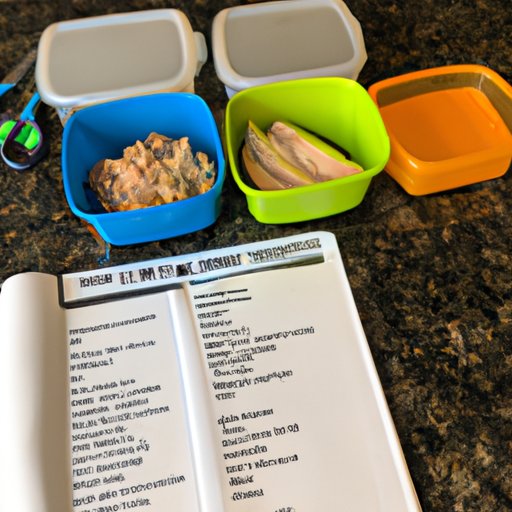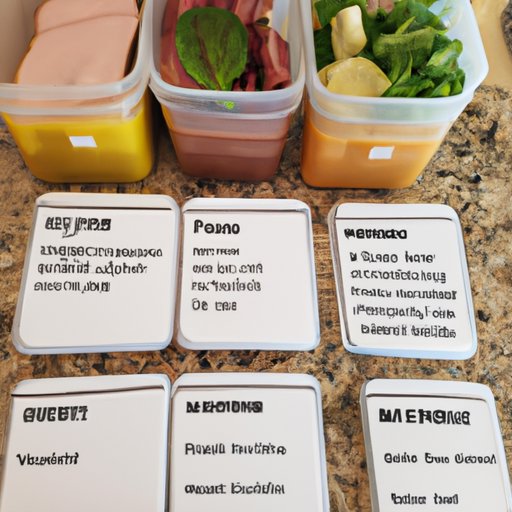Introduction
Dieting for abs is the practice of following a specific set of dietary guidelines to help improve the appearance of your abdominal muscles. It involves creating a detailed nutritional plan that focuses on macronutrient balance, consuming low-glycemic foods, incorporating interval training, increasing protein intake, and learning how to meal prep. This combination of strategies helps to maximize ab definition while also promoting fat loss and muscle building.

Creating a Nutritional Plan to Maximize Ab Definition
The first step to dieting for abs is to create a comprehensive nutritional plan. This requires calculating your daily calorie needs based on your current weight, activity level, and goals. For example, if you’re trying to lose weight, you’ll need to consume fewer calories than you burn each day. Once you have an idea of your daily calorie needs, you can then focus on balancing your macronutrients (carbs, fats, and proteins). A good starting point is to aim for 40% carbohydrates, 30% fat, and 30% protein.
When it comes to what foods to include in your plan, focus on whole, minimally processed foods such as lean proteins, fruits, vegetables, nuts, seeds, and healthy fats. Processed foods are typically high in added sugars and unhealthy fats, so they should be avoided as much as possible.
Eating Low-Glycemic Foods to Promote Fat Loss
Another important aspect of dieting for abs is to focus on eating low-glycemic foods. Low-glycemic foods are those that have a low impact on blood sugar levels and are slowly digested. Examples include whole grains, legumes, fruits, vegetables, and nuts. These foods take longer to digest and therefore keep you feeling full for longer periods of time. They also help to regulate blood sugar levels, which can help reduce cravings for sugary or processed foods.
In addition to helping with weight loss, low-glycemic foods can also help reduce inflammation and improve overall health. Examples of low-glycemic foods include oatmeal, quinoa, sweet potatoes, apples, berries, beans, lentils, and nuts.

Incorporating Interval Training to Burn Calories
In addition to creating a nutritious meal plan, it’s important to incorporate interval training into your workout routine. Interval training is a type of exercise that alternates between periods of intense activity and rest. During the intense periods, you’ll push yourself to your maximum effort, and during the rest periods, you’ll take a break. This type of exercise is effective at burning calories and improving cardiovascular endurance.
Examples of interval training include sprints, burpees, mountain climbers, jump squats, and plank jacks. Try to do at least two to three sessions of interval training per week for best results.
Increasing Protein Intake for Muscle Building
It’s also important to increase your protein intake when dieting for abs. Protein is essential for muscle building and recovery, so it’s important to make sure you’re getting enough. The recommended amount of protein per day is 0.8 grams per kilogram of body weight. So, if you weigh 70 kg, you should aim to consume 56 grams of protein per day.
Good sources of protein include lean meats, fish, eggs, dairy products, nuts, and legumes. Aim to include some form of protein in every meal and snack to ensure you’re meeting your daily needs.

Learning How to Meal Prep for Long Term Success
Finally, it’s important to learn how to meal prep for long term success. Meal prepping involves preparing several meals and snacks ahead of time, typically on one day of the week. This allows you to have healthy and convenient meals on hand throughout the week, which saves time and energy.
To get started, create a weekly meal plan and grocery list. Then, shop for all of the ingredients you need and prepare the meals in advance. Try to include a variety of different foods in your meal plan to ensure you’re getting all of the necessary vitamins and minerals.
Conclusion
Dieting for abs is an effective way to improve the appearance of your abdominal muscles. It involves creating a nutritional plan, eating low-glycemic foods, incorporating interval training, increasing protein intake, and learning how to meal prep. By following these steps, you can maximize ab definition while also promoting fat loss and muscle building.
We hope this article has given you a better understanding of how to diet for abs. Remember to start slowly and gradually increase the intensity of your workouts as you become more comfortable. With dedication and consistency, you’ll be well on your way to achieving your fitness goals.
(Note: Is this article not meeting your expectations? Do you have knowledge or insights to share? Unlock new opportunities and expand your reach by joining our authors team. Click Registration to join us and share your expertise with our readers.)
